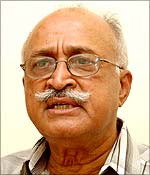 Colonel R Hariharan is a retired military intelligence officer. He is a prolific writer on insurgency and terrorism. His comments on developments in Bangladesh, Myanmar and Sri Lanka are regarded highly professional and rational. He served in Sri Lanka as the head of intelligence for the Indian Peace Keeping Force between 1987 and 1990.
Colonel R Hariharan is a retired military intelligence officer. He is a prolific writer on insurgency and terrorism. His comments on developments in Bangladesh, Myanmar and Sri Lanka are regarded highly professional and rational. He served in Sri Lanka as the head of intelligence for the Indian Peace Keeping Force between 1987 and 1990.
His experience in Sri Lanka gives him an edge in understanding of the ethnic conflict. Here is his latest commentary on the unfolding tragedy for Sri Lankan Tamils. In an e-mail interview with rediff.com's Sheela Bhatt the colonel provides his insight into the war tactics adopted by the Liberation Tigers of Tamil Eelam and other relevant issues.
Do you think the plight of 180,000 lakh Sri Lankan Tamils could have been avoided by the Sri Lankan army while taking on the LTTE?
Isn't it quite different from the Indian Army's handling of similar situations in the northeast, Punjab or Kashmir at various point of time?
Both the LTTE and the Sri Lankan army are responsible for the crisis regarding civilians trapped in the war zone. And the civilians are also partly to blame for the situation developing into a crisis. The civilian population involved is a mixed bag of LTTE supporters and their families, families of LTTE members, ordinary people, and officials of various kinds.
The convergence of civilians into LTTE-held areas started when the war advanced slowly from Mannar district but it spread after the fall of Paranthan-Kilinochchi. The civilians fled at the behest of the LTTE because they were scared of their treatment at the hands of the Lankan army and they were still hopeful that the LTTE would hit back.
When the war intensified further, at the request of the Red Cross, it was the Sri Lanka government that declared a safe no fire zone first in an area east of Mankulam. Then it was shifted further to the interior as the army succeeded in pushing back the LTTE dramatically.
>> Full Story
Thursday, April 30, 2009
'Civilians are part of the LTTE concept of war'
Posted by media at 10:49 PM
Subscribe to:
Post Comments (Atom)











0 comments:
Post a Comment